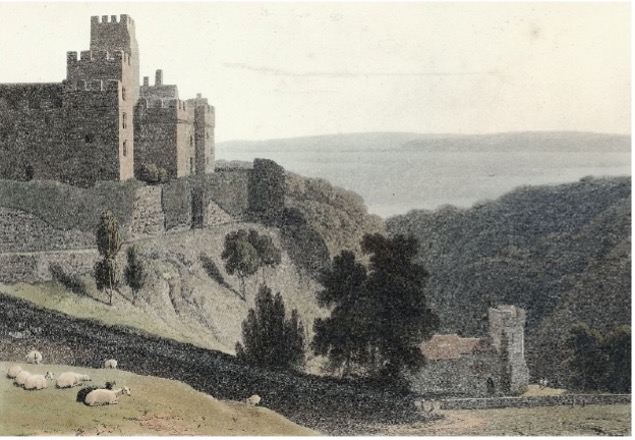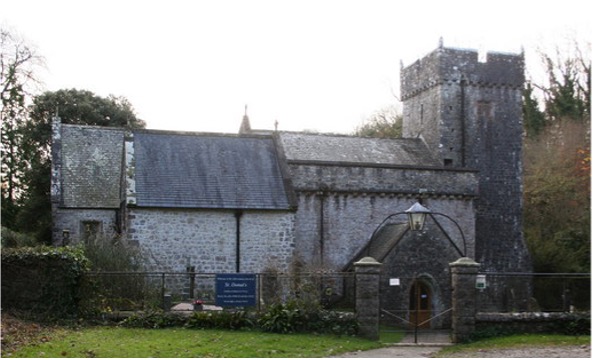St Donats - St Donat

Nestling in a little wooded cwm below the walls of St Donat’s Castle is St Donat’s Church, originally erected by the de Hawey family when they built the castle in the 12th century. It is accessed through the grounds of Atlantic College, the first of the United World Colleges. The Welsh form of Donat is Dunwyd, but nothing is known of the saint. It is thought that the church could be dedicated to St. Donatus, a fourth century Roman nobleman who became bishop of Arezzo and died as a martyr about 361.
What we see in the present church are five stages of building. The round-headed chancel arch is part of the original 12th century church. The tower is early 14th century. The Lady or Stradling chapel on the north of the chancel is late 14th century. The chancel was rebuilt in the 15th century and the nave in the 16th. These stages of building correspond with the stages of building of the castle. The church was restored in 1878.

There are a number of interesting features in the church. The circular font, with fish scale ornament around the top is Norman. In the nave, a Tudor arch is over a small blocked up doorway; this is known as the ‘soldier’s door’ through which it is said Oliver Cromwell’s soldiers entered the church when they occupied the castle. Two long-living residents of the parish are commemorated in the porch – Francis Stych, who died in 1671 aged 108 years, and John Harry, who died in 1792 aged 110 years. The glass in the north window of the chancel is said to be from the 16th century and may have been imported. The decoration includes a cross, a martyr’s crown and the letter D in which is the letter S, signifying St Donat. With the exception of one, the other windows in the church contain Victorian stained glass, many in memory of members of the Stradling-Carne family. The exception is the glass in north window in the nave, which was designed by Roy Coomber and inserted in 2007 to commemorate the Millennium. The left roundel depicts St Donat’s Castle, reflecting the church’s close link with Atlantic College, students from which attend services. The right roundel shows an RNLI Atlantic class inshore rescue boat, designed by and named after the college, and reflects the Church’s long ministry to seafarers on the Glamorgan Heritage Coast, sailors from ship-wrecks being buried in many of the churchyards. A wheatsheaf symbolises the link the Church has with the local farming community.
Unfortunately the Lady Chapel or Stradling Chapel, rebuilt by Sir Thomas Stradling in 1540 when it became the burial place of the Stradling family, is normally kept locked. In 1991 three painted panels showing various members of the Stradling family, were stolen. While they were recovered, they are now housed in the National Museum of Wales, Cardiff, with a photographic reproduction of one of the panels in the church. The panels were commissioned by Sir Edward Stradling and painted by an artist called Byrd in 1590. A 17th century marble monument to Sir Edward (died 1609) and his wife Agnes is on the north wall of the chapel, and in the centre of the chapel is a marble tomb-chest commemorating Sir Edward Stradling (died 1726) and Sir Thomas Stradling (died 1738), the last of the line.
On the south side of the churchyard is a 15th century Calvary cross, with the Crucifixion carved on one side and the crowned figure of the Virgin Mary on the other.
St Donat’s Church is listed Grade I ‘as an important early medieval church with the particularly fine Stradling Chapel and for its historic associations with St. Donat's Castle’.
Ordnance Survey Grid Reference: SS 93368 68064
Post-code (for Sat Nav): CF61 1YZ
what3words: bolsters.scrolled.soft
Times of Sunday services: 11.15a.m.